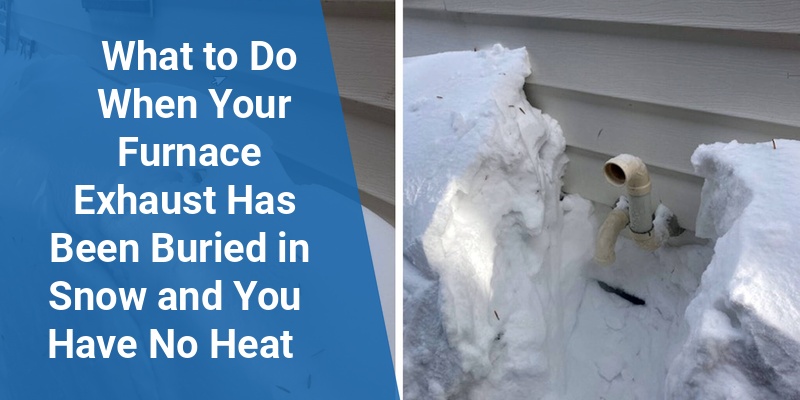When winter storms hit, heavy snowfall can cover and block your furnace exhaust pipe, causing your heating system to stop working effectively. After clearing the snow, it can be confusing and frustrating to find your furnace still not providing heat. This issue is common in cold climates and requires some troubleshooting to ensure safety and restore warmth quickly. Understanding why your furnace won’t heat even after clearing the exhaust is critical to preventing damage and ensuring a safe home environment.
| Issue | Potential Cause | Recommended Action |
|---|---|---|
| Furnace Exhaust Buried in Snow | Blocked vent preventing proper air flow and combustion | Clear snow and debris from exhaust and intake vents promptly |
| No Heat After Clearing Exhaust | Safety lockout triggered or residual system error | Reset furnace power and check error codes, call professional if unresolved |
| System Won’t Restart | Carbon monoxide sensors or pressure switches malfunctioning | Inspect or replace faulty sensors; call HVAC technician |
Why Furnace Exhaust Blockage Stops Heat Production
Furnaces rely on proper ventilation to exhaust combustion gases safely and draw fresh air for burning fuel. When the exhaust vent is buried by snow, it restricts airflow, causing the furnace to detect unsafe operating conditions. Modern furnaces have safety switches that shut off the burner to prevent dangerous buildup of carbon monoxide or incomplete combustion. This safety mechanism leads to your heating system stopping even before any heat is produced.
Steps to Take Immediately After Clearing Snow from Furnace Exhaust
After successfully clearing the snow, several steps can help restore your furnace’s operation:
- Inspect Both Exhaust and Intake Vents: Snow may have also blocked the intake vent, which needs to be clear for the furnace to restart.
- Check for Visible Damage: Examine the vent pipes for cracks or dents caused by snow pressure.
- Reset Your Furnace: Turn off the power to your furnace at the circuit breaker, wait about 30 seconds, and switch it back on to reset the system.
- Observe Furnace Behavior: See if the furnace attempts to restart and if any error codes appear on the control panel.
Common Reasons Why Heat Doesn’t Resume After Clearing Exhaust Snow
If your furnace still won’t produce heat after the exhaust is cleared, the reasons might include:
- Safety Lockout Mode: The system may stay locked to prevent damage or hazards until manually reset or serviced.
- Faulty Pressure Switches: These switches detect vent blockage and if damaged, they can falsely signal an obstruction.
- Carbon Monoxide Detectors Triggered: If dangerous gases were detected, the furnace may require inspection and reset by a professional.
- Electrical or Control Board Issues: Power surges or faults during blockage may cause system malfunctions.
When and How to Reset Your Furnace Safely
Many furnaces have a reset function accessible via a button, switch, or circuit breaker:
- Turn off the thermostat to prevent immediate restart issues.
- Switch off the furnace power at the main breaker or furnace switch.
- Wait at least 30 seconds to allow system capacitors to discharge.
- Turn power back on and restart the thermostat.
- Pay attention to any error codes or unusual noises.
If the furnace does not resume heating or error codes persist, call a licensed HVAC technician to avoid safety risks.
Preventive Measures to Avoid Furnace Exhaust Blockages
Winter safety can be improved by taking proactive measures:
Call 888-906-9139 for Free Local HVAC Quotes – No Obligation, Just Savings!
- Install Snow Guards or Protective Covers: These help prevent snow accumulation around exhaust and intake vents.
- Regularly Clear Snow During Storms: Check vents after heavy snowfall and ice storms.
- Ensure Proper Vent Placement: Exhausts should be positioned away from areas prone to deep snow drifts.
- Schedule Annual Furnace Inspections: Professionals can verify that sensors, switches, and ventilation are functioning correctly.
Signs It’s Time to Call a Professional HVAC Technician
After clearing the exhaust and resetting, professional help is necessary if you experience:
- No heat despite multiple resets
- Persistent error codes or flashing lights on the furnace panel
- Unusual odors such as gas or burning smells
- Carbon monoxide detector alarms
- Frequent cycling on and off or strange noises
HVAC technicians have the tools and expertise to diagnose safety sensors, pressure switches, and electrical components that affect furnace operation after exhaust blockage events.
Importance of Carbon Monoxide Safety During Furnace Blockages
Blocked furnace vents can cause dangerous carbon monoxide buildup. Carbon monoxide is a colorless, odorless gas that can be fatal when inhaled. Ensuring your carbon monoxide detectors are functioning correctly and that furnace exhaust vents remain clear are essential safety practices, especially in snowy conditions. If your furnace is not producing heat due to vent blockage, do not ignore carbon monoxide detector alerts.
Tips for Maintaining Furnace Efficiency in Harsh Winters
- Keep The Area Around Vents Clear: Regularly remove snow, ice, and debris.
- Perform Routine Furnace Tune-Ups: Professional servicing ensures sensors and safety devices work as intended.
- Use Weatherproof Vent Covers: Designed to prevent clogging while allowing safe ventilation.
- Replace Air Filters Frequently: Clean filters improve airflow and system efficiency.
Summary
When snow blocks your furnace exhaust, it triggers safety shutdowns to protect from carbon monoxide risks. Clearing snow is the first step, but the system may require resets or professional servicing to fully restore heat. Regular maintenance and preventive measures can reduce the chances of exhaust blockage and heating failures in winter.
